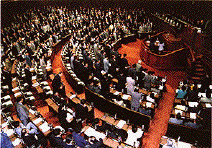 Science & Technology || Search || Back Numbers DIET TV: The Debut of Broadcast Diet Sessions March 13, 1998 
Diet sessions may soon become a household affair. (Photo: Kyodo) In January of this year, a private satellite television channel launched a program featuring unadulterated ordinary Diet sessions. The footage, of meetings in both houses, was offered by the Diet free of charge. This is the first time that the unedited and unabridged televising of Diet deliberations has been permitted in Japan. As well as responding to the public's desire for open information, it is hoped that this move will heighten interest in politics at the same time. Discussion is under way in the House of Representatives (the Lower House) on how to effectuate independent state-run broadcasting of Diet sessions as well. Ordinary Diet Sessions Aired From January The first channel to transmit meetings of the Diet debuted on January 12, coinciding with the reopening of the Diet's ordinary session. C-NET, a Tokyo-based communication satellite (CS) broadcasting production company, aired footage provided free by the Diet on "Diet TV," a political channel run by PerfecTV!, a CS digital broadcasting company. In principle, Diet deliberations will be shown in full, free from editing, cutting, and commentary. When different committee meetings take place simultaneously, one will be aired live and the others recorded to be shown in a later slot. C-NET is also the general Japanese agency for the nonprofit political channel C-SPAN, established by an American cable television group; when the Japanese Diet is in recess, it will broadcast a digest program of the contents of the American political channel. The channel viewing fee is only 200 yen (1.50 U.S. dollars at 130 yen to the dollar) per month. As the company explains, "We have slashed the price to serve Japanese democracy. By making our program accessible to many people, public interest in and awareness of politics in Japan will be heightened." The decision to allow the media to broadcast Diet sessions cost-free was
taken last fall in both the House of Representatives and House of
Councilors. Television channels such as those operated by NHK (Japan
Broadcasting Corporation) and private domestic and foreign terrestrial
channels, radio stations, CS channels, and communication companies have
already closed contracts to receive relayed Diet footage. At present C-NET
is the only channel relaying Diet sessions at present, but a variety of
media are expected to make use of Diet session broadcasts from now on.
Nonetheless, numerous problems concerning independent broadcasting still
exist. The current Broadcast Law, which makes no provisions for state-run
Diet broadcasts, will have to be changed; and the Lower House will have to
make provisions for a budget as well as for equipment installation and
other preparations. A special group within the subcommittee is currently
preparing the way forward for state broadcasts.
Furthermore, through its tie-up with C-NET, C-SPAN is broadcasting Japanese Diet sessions in the United States. From now on, the Diet--open for all to see--will be scrutinized by viewers all over the world. There seem to be several benefits to come of televising Diet sessions: Diet members will have to conduct their meetings seriously, people will have the opportunity to see the uncensored workings of the Diet at home, people will be able to judge the political decision-making process for themselves. The broadcast of Congressional sessions has already taken root in the United States, but how will the Japanese respond to televised Diet sessions? Whether or not the quality of democracy and politics in Japan is improved depends on how the Japanese make use of this access to new information.  Edited by Japan Echo Inc. based on domestic
Japanese news sources. Articles presented here are offered for reference
purposes and do not necessarily represent the policy or views of the Japanese
Government. Edited by Japan Echo Inc. based on domestic
Japanese news sources. Articles presented here are offered for reference
purposes and do not necessarily represent the policy or views of the Japanese
Government.
|
